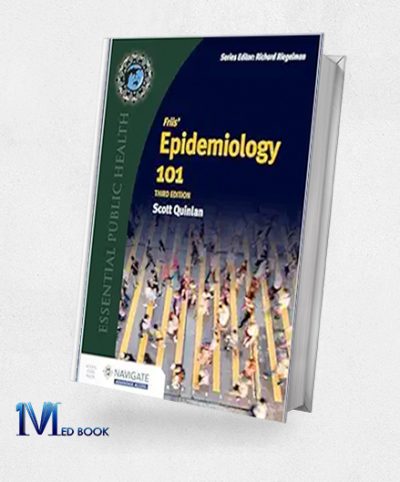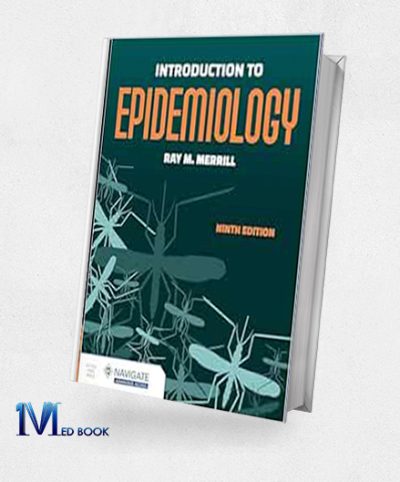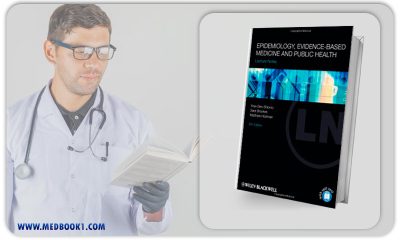Epidemiology
Clinical Biostatistics and Epidemiology Made Ridiculously Simple (High Quality PDF)
Original price was: $32.00.$25.00Current price is: $25.00.Friis’ Epidemiology 101, 3rd Edition (EPub+Converted PDF)
Original price was: $104.95.$35.00Current price is: $35.00.Introduction To Epidemiology, 9th Edition (EPub+Converted PDF)
Original price was: $105.95.$37.00Current price is: $37.00.Introduction to Public Health 5th edition (True PDF)
Original price was: $50.00.$28.00Current price is: $28.00.Lecture Notes Epidemiology Evidence-based Medicine and Public Health 6th Edition (Original PDF from Publisher)
Original price was: $40.00.$21.00Current price is: $21.00.Epidemiology
Introduction to Epidemiology:
Epidemiology stands at the forefront of safeguarding public health by unraveling the intricate tapestry of disease within populations. It is a scientific discipline that delves into the patterns, causes, and effects of health and disease conditions among communities. At its core, epidemiology seeks to understand how diseases spread, why certain populations are more susceptible, and what factors contribute to their occurrence.
In the realm of public health, epidemiology serves as a crucial tool for identifying and comprehending the determinants that influence health outcomes on a large scale. By meticulously studying the distribution and determinants of diseases, epidemiologists provide invaluable insights that guide policymakers, healthcare professionals, and communities in the development of effective preventive measures and interventions.
The importance of epidemiology lies in its ability to transcend individual cases, focusing instead on the broader context of population health. By scrutinizing patterns of diseases, epidemiologists can discern trends, detect emerging threats, and formulate evidence-based strategies to mitigate the impact of health challenges. Through this systematic approach, epidemiology not only aids in the prevention and control of diseases but also contributes to the optimization of public health policies, resource allocation, and healthcare delivery.
In this exploration of epidemiology, we delve into the pivotal role it plays in shaping the landscape of public health. As we navigate the intricate web of disease patterns and determinants, we uncover the power of epidemiology in safeguarding communities and promoting the well-being of populations.
Foundations of Epidemiology:
Epidemiology, as a scientific discipline, operates on a set of foundational principles that form the bedrock of understanding, preventing, and controlling diseases within populations. Three key concepts—incidence, prevalence, and the epidemiological triad—serve as fundamental building blocks in this pursuit.
- Incidence:
Incidence refers to the number of new cases of a particular disease within a defined population over a specified period. It is a critical measure in epidemiology as it helps gauge the risk of individuals developing a specific illness. By examining incidence rates, epidemiologists can identify trends and patterns, allowing for the timely implementation of preventive measures. Incidence provides insights into the dynamics of disease transmission and aids in the allocation of resources for targeted interventions.
- Prevalence:
Prevalence, on the other hand, represents the total number of existing cases (both new and pre-existing) of a disease within a population at a given point in time. This metric offers a broader perspective on the burden of a disease within a community. High prevalence may indicate chronicity or long-term impact, necessitating strategies for disease management and healthcare planning. Understanding prevalence is crucial for estimating the societal impact of a disease and tailoring healthcare services to meet the needs of affected populations.
- Epidemiological Triad:
The epidemiological triad is a conceptual framework that explores the interplay between three essential components—host, agent, and environment. This triad forms the basis for understanding the dynamics of infectious diseases. The host represents the individual or population susceptible to the disease, the agent is the infectious microorganism or factor causing the disease, and the environment encompasses the external factors influencing the disease’s transmission. By comprehensively examining the interactions within this triad, epidemiologists gain insights into the complex factors influencing disease occurrence. This understanding, in turn, informs the development of targeted interventions to disrupt the transmission cycle and control the spread of diseases.
In summary, the foundational principles of epidemiology, including incidence, prevalence, and the epidemiological triad, are indispensable tools for unraveling the complexities of diseases in populations. These concepts not only contribute to a deeper understanding of disease dynamics but also guide public health efforts in developing effective strategies for disease prevention, control, and health promotion.
Types of Epidemiological Studies:
Epidemiological studies are essential in uncovering patterns, risk factors, and causal relationships related to health phenomena. These studies can be broadly categorized into two main types: observational studies and experimental studies.
- Observational Studies:
– Descriptive Studies: These studies aim to characterize the distribution of health-related events within a population. They provide a foundation for generating hypotheses and understanding the natural history of diseases. However, they do not establish causation.
– Analytical Studies:
– Cross-Sectional Studies: These studies assess the prevalence of health-related outcomes and exposures at a single point in time. They are useful for generating hypotheses but are limited in establishing temporality and causation.
– Case-Control Studies: These studies compare individuals with a particular health condition (cases) to those without the condition (controls) and retrospectively assess exposures. They are efficient for rare diseases but susceptible to recall bias.
– Cohort Studies: These studies follow a group of individuals over time, assessing exposures and outcomes. They provide valuable information on causality but can be resource-intensive and time-consuming.
- Experimental Studies:
– Randomized Controlled Trials (RCTs): In RCTs, participants are randomly assigned to either an intervention or a control group. This randomization helps control for confounding factors, making RCTs the gold standard for establishing causation. However, ethical considerations and practical constraints can limit their feasibility.
– Quasi-Experimental Studies: These studies lack randomization but include an intervention and a control group. While they provide valuable insights, the absence of randomization makes them more susceptible to bias compared to RCTs.
Strengths and Limitations:
- Observational Studies:
– Strengths:
– Provide a real-world context, allowing the study of diverse populations.
– Often more feasible and ethical than experimental designs.
– Limitations:
– Prone to confounding variables that may affect the observed associations.
– Cannot establish causation definitively, only suggest associations.
- Experimental Studies:
– Strengths:
– Gold standard for establishing causation due to randomization.
– Can control for confounding factors more effectively.
– Limitations:
– May not be ethically feasible for certain research questions.
– Resource-intensive and may have limited generalizability.
In conclusion, both observational and experimental studies play crucial roles in epidemiology, each with its strengths and limitations. The choice between them depends on the research question, ethical considerations, and practical constraints. Integrating findings from various study types can provide a more comprehensive understanding of health-related phenomena.
Role of Epidemiologists:
Epidemiologists play a pivotal role in public health by employing scientific methods to understand, monitor, and control the spread of diseases within populations. Their responsibilities encompass a range of activities, including disease surveillance, outbreak investigations, and the formulation of strategies for disease prevention and control.
- Disease Surveillance:
– Monitoring Health Trends: Epidemiologists systematically collect, analyze, and interpret health data to monitor trends in disease occurrence. This involves tracking the incidence and prevalence of diseases over time and across different populations.
– Early Detection: Epidemiologists use surveillance systems to identify potential outbreaks or unusual patterns of diseases. Early detection is crucial for implementing timely interventions and preventing the further spread of infectious agents.
- Outbreak Investigations:
– Identification of Causative Agents: When an outbreak occurs, epidemiologists conduct investigations to identify the causative agents, whether infectious or environmental. This involves collecting and analyzing data on affected individuals, their exposures, and the potential sources of the outbreak.
– Source Tracing: Epidemiologists work to trace the source of the outbreak, whether it’s contaminated food, a specific location, or other factors. Understanding the source is essential for implementing targeted control measures.
– Control Measures: Based on their findings, epidemiologists collaborate with public health officials to recommend and implement control measures. This may include quarantine, vaccination campaigns, or other interventions to contain the outbreak.
- Formulating Strategies for Disease Prevention and Control:
– Risk Assessment: Epidemiologists assess the risk factors associated with diseases to understand their determinants. This information is crucial for developing targeted prevention strategies.
– Policy Recommendations: Epidemiologists provide evidence-based recommendations to policymakers and public health agencies. Their input guides the formulation of public health policies and interventions aimed at preventing and controlling diseases.
– Community Education: Epidemiologists play a role in educating the public about health risks and promoting preventive behaviors. This includes disseminating information on vaccination, hygiene practices, and other measures to reduce the spread of diseases.
In summary, epidemiologists serve as key players in public health, contributing to disease surveillance, outbreak investigations, and the formulation of strategies for disease prevention and control. Their work not only involves understanding the epidemiology of diseases but also translating that knowledge into actionable measures to protect and improve the health of communities.
Epidemiology and Infectious Diseases:
Epidemiology is closely intertwined with the study of infectious diseases, providing a systematic and scientific approach to understanding their spread, identifying risk factors, and formulating effective control measures. The application of epidemiological methods in the context of infectious diseases is instrumental in mitigating the impact of outbreaks and improving overall public health.
- Studying the Spread of Infectious Diseases:
– Incidence and Prevalence: Epidemiologists use these measures to quantify the occurrence of infectious diseases within populations over time. The incidence reveals the rate of new cases, while prevalence indicates the total number of existing cases. These metrics help in understanding the dynamics of disease transmission.
– Transmission Dynamics: Epidemiological studies examine how infectious agents are transmitted among individuals and populations. This involves assessing modes of transmission, incubation periods, and factors influencing the spread of infections.
- Identifying Risk Factors:
– Case-control studies and Cohort Studies: Epidemiologists employ these observational study designs to identify risk factors associated with the acquisition of infectious diseases. By comparing individuals with and without the disease, researchers can pinpoint factors such as behaviors, exposures, or demographic characteristics that contribute to susceptibility.
– Cross-Sectional Studies: These studies provide a snapshot of the prevalence of both the disease and potential risk factors at a specific point in time, aiding in the identification of associations.
- Control Measures:
– Outbreak Investigations: Epidemiologists play a crucial role in investigating and managing infectious disease outbreaks. By analyzing data on affected individuals, their contacts, and potential sources, they contribute to the identification and implementation of control measures.
– Vaccination Programs: Epidemiological research informs the development and implementation of vaccination strategies. This includes assessing the effectiveness of vaccines, determining optimal vaccination schedules, and identifying target populations for immunization to achieve herd immunity.
– Quarantine and Isolation: Epidemiologists contribute to the design and evaluation of strategies such as quarantine and isolation to prevent the spread of infectious diseases. These measures are especially important during outbreaks of highly contagious pathogens.
- Surveillance Systems:
– Monitoring and Early Detection: Epidemiologists establish and maintain surveillance systems to monitor the occurrence of infectious diseases. Early detection through surveillance allows for timely response, reducing the impact of outbreaks and facilitating the implementation of control measures.
In conclusion, epidemiological methods are essential in unraveling the complexities of infectious diseases. By studying their spread, identifying risk factors, and contributing to the formulation of control measures, epidemiologists play a critical role in preventing and managing infectious disease threats, ultimately safeguarding public health.
Chronic Disease Epidemiology
Chronic disease epidemiology focuses on the study of long-term health conditions that often develop and persist over an extended period. These diseases, such as heart disease, diabetes, cancer, and chronic respiratory conditions, pose significant challenges to public health. Epidemiologists employ various approaches to investigate the causes, prevalence, and prevention of chronic diseases within populations.
- Studying Causes of Chronic Diseases:
– Risk Factor Identification: Epidemiologists investigate the factors contributing to the development of chronic diseases. This includes behavioral, genetic, environmental, and socio-economic factors. Observational studies, particularly cohort and case-control studies, are commonly employed to identify and quantify associations between potential risk factors and the onset of chronic diseases.
– Multifactorial Analysis: Chronic diseases often result from the interplay of multiple factors. Epidemiological methods help disentangle these complex relationships by considering various exposures and their cumulative effects.
- Prevalence and Burden of Chronic Diseases:
– Descriptive Epidemiology: Epidemiologists use descriptive studies to characterize the distribution and burden of chronic diseases within populations. This involves assessing the prevalence of specific conditions, examining trends over time, and identifying vulnerable demographic groups.
– Global Burden of Disease Studies: Epidemiologists contribute to global efforts to quantify the burden of chronic diseases through initiatives like the Global Burden of Disease Study. These endeavors provide a comprehensive understanding of the impact of chronic diseases on a global scale.
- Prevention of Chronic Diseases:
– Intervention Studies: Epidemiologists design and implement intervention studies, including randomized controlled trials (RCTs), to assess the effectiveness of preventive measures. This may involve lifestyle modifications, such as dietary changes, physical activity promotion, or smoking cessation programs.
– Screening Programs: Epidemiology plays a role in the development and evaluation of screening programs for early detection of chronic diseases. Early identification allows for timely intervention and management, potentially reducing the severity and progression of these conditions.
– Policy Recommendations: Epidemiologists contribute evidence-based recommendations to inform public health policies aimed at preventing and controlling chronic diseases. These recommendations may involve legislative measures, health education campaigns, or strategies to improve access to healthcare.
- Longitudinal Studies:
– Cohort Studies: Longitudinal studies, particularly cohort designs, are valuable for tracking individuals over time to understand the natural history of chronic diseases. These studies provide insights into the cumulative effects of exposures and the development of diseases over extended periods.
In summary, chronic disease epidemiology plays a crucial role in advancing our understanding of the causes, prevalence, and prevention of long-term health conditions. By employing diverse epidemiological approaches, researchers contribute to the development of effective strategies for reducing the burden of chronic diseases and improving the overall health and well-being of populations.
Environmental Epidemiology:
Role of Epidemiology in Studying Environmental Factors on Health:
Epidemiology plays a crucial role in investigating the impact of environmental factors on health. Environmental epidemiologists utilize various methods to assess the relationships between exposures to environmental agents and health outcomes, contributing to the understanding and mitigation of adverse health effects associated with environmental factors.
- Exposure Assessment:
– Measurement of Exposures: Epidemiologists employ exposure assessment methods to quantify individuals’ contact with environmental factors. This may include air and water quality, exposure to hazardous substances, noise levels, or other environmental pollutants. Accurate measurement of exposures is fundamental to understanding their potential health effects.
– Biomonitoring: Epidemiological studies often incorporate biomonitoring, where biological samples such as blood or urine are analyzed to assess internal exposure levels. Biomonitoring provides a direct measure of the body’s response to environmental exposures.
- Health Impact Assessment:
– Disease Surveillance: Epidemiologists use surveillance systems to monitor the occurrence of diseases associated with environmental exposures. This helps identify trends, clusters, or unusual patterns of health outcomes related to specific environmental factors.
– Case-Control and Cohort Studies: These study designs are commonly employed to assess the association between environmental exposures and health outcomes. Case-control studies compare individuals with a specific health condition to those without, focusing on past exposures. Cohort studies follow a group of individuals over time, allowing for the examination of long-term health effects associated with environmental exposures.
- Risk Assessment:
– Quantifying Risks: Epidemiology contributes to the quantitative assessment of health risks associated with environmental exposures. By estimating relative risks and attributable fractions, researchers provide valuable information to policymakers and public health officials for prioritizing interventions and regulatory measures.
– Dose-Response Relationships: Epidemiological studies help establish dose-response relationships, elucidating how the magnitude of exposure relates to the likelihood and severity of health effects. This information is critical for setting exposure standards and guidelines.
- Mitigation and Prevention:
– Policy Recommendations: Epidemiologists contribute evidence to inform the development of environmental health policies and regulations. This may involve setting exposure limits, implementing pollution control measures, or establishing guidelines for safe practices.
– Intervention Studies: Epidemiological research may guide the design and evaluation of interventions to mitigate the health effects of environmental exposures. These interventions could include public health campaigns, community education, or engineering solutions to reduce exposures.
– Community Engagement: Epidemiologists often work collaboratively with communities affected by environmental exposures, involving them in the research process, and empowering them with knowledge to advocate for their health. Community-based interventions are essential for addressing environmental health disparities.
In summary, epidemiology serves as a powerful tool for studying the impact of environmental factors on health. Through rigorous exposure assessment, health impact assessment, risk assessment, and mitigation strategies, epidemiologists contribute to safeguarding public health by understanding and addressing the complex relationships between environmental exposures and adverse health outcomes.
Emerging Trends in Epidemiology:
Epidemiology, as a field, continues to evolve with advancements in technology, the availability of big data, and progress in genomics. These emerging trends are transforming the way researchers study health patterns and contribute to a deeper understanding of the factors influencing disease occurrence.
- Technological Innovations:
– Wearable Devices and Sensors: The widespread use of wearable devices and sensors provides real-time health data, allowing epidemiologists to monitor individuals’ behaviors, physical activity, and physiological parameters. This continuous stream of data contributes to more precise and dynamic health assessments.
– Mobile Health (mHealth) Applications: Mobile apps enable researchers to collect health-related data, conduct surveys, and implement interventions on a large scale. These applications enhance participant engagement, data accuracy, and the efficiency of epidemiological studies.
- Big Data:
– Integration of Electronic Health Records (EHRs): The integration of electronic health records into epidemiological research facilitates the analysis of large datasets, providing a comprehensive view of patients’ medical histories and outcomes. This enables researchers to identify patterns, trends, and associations more efficiently.
– Data Linkages: Big data analytics benefit from linking diverse datasets, such as health records, social determinants, and environmental information. Integrated data sources allow for a more holistic understanding of the complex interactions influencing health outcomes.
- Genomics:
– Precision Epidemiology: Advances in genomics contribute to precision epidemiology, allowing researchers to study how genetic variations influence disease susceptibility and progression. This personalized approach helps identify subgroups within populations that may have distinct risk profiles.
– Polygenic Risk Scores: The development of polygenic risk scores, which aggregate information from multiple genetic variants, enhances the predictive power for certain diseases. This approach aids in identifying individuals at higher risk and tailoring interventions accordingly.
- Machine Learning and Artificial Intelligence (AI):
– Predictive Modeling: Machine learning and AI algorithms enable the development of predictive models for disease occurrence and progression. These models can identify patterns and associations in large datasets, assisting in risk prediction and early intervention strategies.
– Data Mining: Machine learning techniques facilitate the extraction of valuable insights from massive datasets, helping researchers uncover hidden patterns, associations, and potential causal relationships that may not be apparent through traditional statistical methods.
- Global Health Surveillance:
– Digital Disease Detection: Epidemiologists leverage digital technologies and social media for real-time disease surveillance. Monitoring online activity provides early signals of potential outbreaks, enabling rapid response and containment measures.
– Global Collaboration: Advances in communication technologies foster global collaboration in epidemiological research. Researchers from different parts of the world can share data, findings, and methodologies, contributing to a more comprehensive understanding of health patterns on a global scale.
In conclusion, the integration of technological innovations, big data, and genomics into epidemiological research is revolutionizing the field. These advancements enhance the precision, efficiency, and scope of studies, ultimately leading to a more nuanced understanding of health patterns and informing evidence-based public health interventions.
Challenges in Epidemiological Research:
Epidemiological research, while crucial for understanding health patterns and informing public health strategies, faces several challenges that can impact the validity and reliability of study findings. Some key challenges include biases, confounding factors, and ethical considerations.
- Biases:
– Selection Bias: Arises when the study sample is not representative of the target population, leading to skewed or non-generalizable results. Overcoming selection bias requires careful consideration of sampling methods and efforts to ensure a diverse and representative study population.
– Recall Bias: Occurs when participants inaccurately recall past exposures or events, particularly in retrospective studies. This bias can lead to misclassification of exposure and outcome variables, affecting the validity of study results.
- Confounding Factors:
– Confounding: Refers to the presence of an extraneous factor that is associated with both the exposure and the outcome, potentially leading to erroneous conclusions about the true relationship between the two. Addressing confounding requires careful study design, statistical techniques, and consideration of potential confounders in data analysis.
– Residual Confounding: Despite efforts to control for confounding, residual confounding may still exist, leading to uncertainties in the interpretation of study results. Researchers must acknowledge and discuss potential residual confounding in their findings.
- Ethical Considerations:
– Informed Consent: Obtaining informed consent is crucial in epidemiological research, ensuring that participants are aware of the study’s purpose, potential risks, and benefits. Balancing the need for robust data with ethical considerations regarding participant autonomy and privacy is an ongoing challenge.
– Privacy and Confidentiality: Protecting the privacy of study participants and maintaining the confidentiality of their data are paramount. Ethical guidelines and legal frameworks must be adhered to, and researchers must implement robust data security measures to prevent unauthorized access or disclosure.
- Measurement Issues:
– Exposure and Outcome Measurement: Inaccurate measurement of exposures and outcomes can introduce information bias, leading to misclassification and affecting the validity of study findings. Rigorous validation of measurement tools and standardization of assessment protocols are essential to minimize measurement error.
– Misclassification: Misclassification of study participants concerning exposure, outcome, or other variables can compromise the accuracy of results. Researchers must implement strategies to identify and minimize misclassification bias.
- Temporal Relationships:
– Establishing Causality: Determining causality in epidemiological studies is challenging. Temporal relationships are crucial, but establishing a cause-and-effect relationship requires careful consideration of exposure timing, dose-response relationships, and the biological plausibility of observed associations.
- Resource Limitations:
– Budgetary Constraints: Epidemiological studies often require substantial resources for data collection, analysis, and interpretation. Limited funding may restrict the scale and scope of research, affecting the ability to address complex research questions adequately.
– Longitudinal Studies Challenges: Conducting long-term studies to examine chronic diseases or outcomes may face challenges related to participant retention, resource allocation, and logistical complexities over extended periods.
Addressing these challenges in epidemiological research requires a multidisciplinary approach, collaboration, and continuous methodological advancements. Researchers must be transparent about the limitations and uncertainties inherent in their studies, and ongoing efforts to refine methodologies and ethical standards are crucial for advancing the field and improving the quality of epidemiological evidence.
Conclusion:
In conclusion, epidemiology stands as a cornerstone in the realm of public health, contributing invaluable insights into the patterns, determinants, and control of diseases within populations. Through meticulous study designs, data analyses, and interpretation of findings, epidemiologists play a pivotal role in advancing our understanding of health phenomena and shaping evidence-based interventions.
The field of epidemiology has demonstrated its significance in unraveling the complexities of infectious and chronic diseases, studying the impact of environmental factors, and identifying risk factors that shape health outcomes. It has evolved in response to emerging trends, embracing technological innovations, big data analytics, and genomic advancements, which have expanded the horizons of research possibilities and enhanced the precision of our insights.
Despite the progress made, epidemiology faces challenges such as biases, confounding factors, and ethical considerations, underscoring the need for continuous methodological refinement and ethical scrutiny. Efforts to address these challenges, improve study designs, and integrate diverse data sources contribute to the reliability and validity of epidemiological evidence.
Epidemiologists are at the forefront of public health, not only in studying disease occurrence but also in formulating strategies for prevention and control. From disease surveillance to outbreak investigations, epidemiologists navigate the intricate web of health patterns, striving to protect communities and improve global health outcomes.
As we move forward, ongoing collaborations, interdisciplinary approaches, and a commitment to ethical standards remain paramount. The dynamic nature of epidemiology demands adaptability to emerging health threats, innovation in research methodologies, and a global perspective to address health disparities and inequalities.
In the pursuit of better disease prevention and control, epidemiology remains a powerful tool, guiding policymakers, healthcare professionals, and communities toward evidence-based practices. Through a collective commitment to advancing the field, we continue to build a foundation for a healthier future, where the principles of epidemiology serve as beacons guiding public health efforts worldwide.







